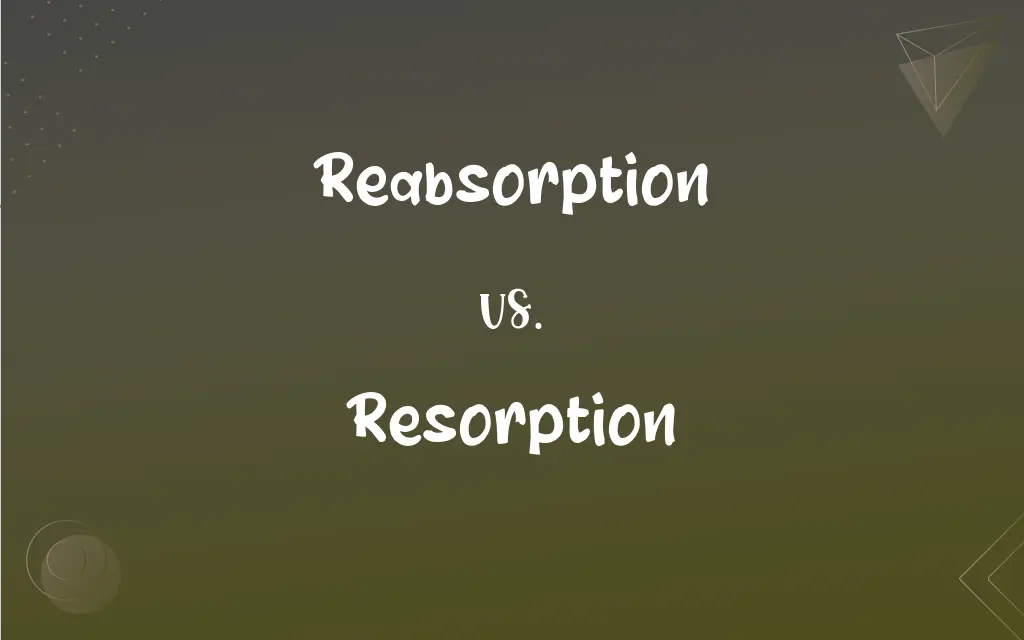Reabsorption vs. Resorption: What's the Difference?
Edited by Aimie Carlson || By Janet White || Published on December 19, 2023
Reabsorption is the process of absorbing substances again, often in kidneys; resorption is the breakdown and assimilation of tissues, like bone.

Key Differences
Reabsorption primarily occurs in the kidneys, where essential substances like water, glucose, and salts are reabsorbed into the bloodstream. In contrast, resorption refers to the process where body tissues, especially bone, are broken down and the minerals are assimilated back into the body. Reabsorption is a selective process, crucial for maintaining homeostasis in the body, whereas resorption is a part of natural physiological processes like bone remodeling.
In reabsorption, specific mechanisms in the kidney tubules actively transport certain substances from the filtrate back into the blood. On the other hand, resorption involves the breakdown of solid tissue, often bone, by cells such as osteoclasts. Reabsorption helps in conserving valuable nutrients and maintaining the body's internal environment, while resorption plays a key role in growth, healing, and maintaining the mineral balance in the body.
The process of reabsorption is critical in regulating the body's water and electrolyte balance, directly impacting kidney function and overall fluid balance. Resorption, particularly of bone, is essential in shaping and repairing bones and is influenced by various hormones and nutritional factors. Reabsorption can be influenced by various factors like hydration levels and hormones, whereas resorption is often affected by age, hormonal changes, and certain diseases.
In the context of diseases, impaired reabsorption in the kidneys can lead to conditions like diabetes insipidus, whereas abnormal resorption can result in osteoporosis. Reabsorption is often targeted by diuretics to treat conditions like hypertension, while treatments for osteoporosis aim to regulate bone resorption.
Both reabsorption and resorption involve the process of absorption, reabsorption is specific to the kidney and vital for fluid and electrolyte balance, and resorption is mainly associated with the breakdown of tissues, particularly bone, playing a crucial role in growth and maintenance.
ADVERTISEMENT
Comparison Chart
Definition
Absorbing substances again, especially in kidneys.
Breakdown and assimilation of body tissues.
Primary Site
Kidneys.
Bones and other tissues.
Function
Conservational, maintaining homeostasis.
Remodeling and recycling of tissues.
Cellular Process
Active transport in kidney tubules.
Action of cells like osteoclasts on tissue.
Related Diseases
Diabetes insipidus, kidney issues.
Osteoporosis, metabolic bone diseases.
ADVERTISEMENT
Reabsorption and Resorption Definitions
Reabsorption
Involves selectively taking back substances filtered out by the kidneys.
Calcium reabsorption in the kidneys is essential for bone health.
Resorption
The process of breaking down and assimilating substances in the body.
Bone resorption by osteoclasts is part of normal bone remodeling.
Reabsorption
A biological process for retaining essential nutrients and compounds.
Sodium reabsorption in the kidneys helps in regulating blood pressure.
Resorption
A physiological process important in growth and healing.
Tooth resorption can sometimes occur in dental diseases.
Reabsorption
An integral kidney function for maintaining bodily homeostasis.
Reabsorption mechanisms in the kidneys adjust according to the body's needs.
Resorption
The process of absorbing materials from body tissues.
In osteoporosis, bone resorption outpaces bone formation.
Reabsorption
The kidney's process of absorbing substances from urine back into the blood.
Reabsorption of glucose in the kidneys is crucial to prevent its loss.
Resorption
Involves the dissolution and recycling of cellular structures.
Resorption of old bone tissue helps in maintaining bone strength.
Reabsorption
The recovery of water and electrolytes from renal tubular fluid.
Adequate water reabsorption is vital to prevent dehydration.
Resorption
Breakdown of hard tissues, primarily bones, for mineral homeostasis.
Calcium and phosphorus are released into the blood through bone resorption.
Reabsorption
To absorb again.
Resorption
The act or process of resorbing.
Reabsorption
To accommodate or accept again, as into a group or category
The economy cannot reabsorb all of the refugees into the workforce.
Resorption
The act of resorbing.
Reabsorption
To undergo resorption.
Resorption
The redissolving, wholly or in part, in the molten magma of an igneous rock, of crystals previously formed.
Reabsorption
(physics) The subsequent absorption of emitted radiation.
Resorption
(medicine) The loss and reassimilation of bone (or other) material.
Reabsorption
(physiology) The subsequent absorption of a secreted substance.
Resorption
The act of resorbing; also, the act of absorbing again; reabsorption.
Reabsorption
The act or process of reabsorbing.
Resorption
The redissolving wholly or in part, in the molten magma of an igneous rock, of crystals previously formed. The dissolved material may again solidify, giving rise to a mass of small crystals, usually of a different kind.
Reabsorption
The organic process in which the substance of some differentiated structure that has been produced by the body undergoes lysis and assimilation
Resorption
The organic process in which the substance of some differentiated structure that has been produced by the body undergoes lysis and assimilation
FAQs
How does reabsorption affect kidney function?
It's crucial for filtering and retaining vital substances.
Can reabsorption be artificially influenced?
Yes, with medications like diuretics.
What regulates kidney reabsorption?
Hormones and the body's hydration status.
Is resorption a natural part of aging?
Yes, especially in bone tissue.
Does resorption play a role in dental health?
Yes, especially in conditions affecting teeth.
How does menopause affect bone resorption?
It can increase due to hormonal changes.
What tissues are primarily involved in resorption?
Mainly bones and sometimes other tissues.
Does reabsorption contribute to blood pressure regulation?
Yes, through sodium and water reabsorption.
Can diseases affect bone resorption?
Yes, diseases like osteoporosis can impact it.
Is resorption reversible?
It's part of a continuous cycle, balanced with formation.
Can reabsorption malfunction?
Yes, leading to conditions like diabetes insipidus.
What is the main role of reabsorption?
To conserve water, nutrients, and electrolytes in the body.
What is the significance of resorption in orthodontics?
It's important in tooth movement and alignment.
Do diuretics target a specific type of reabsorption?
Yes, mainly sodium and water reabsorption.
What cells are involved in bone resorption?
Osteoclasts are primarily responsible.
Are there different types of reabsorption?
Yes, like tubular and glomerular reabsorption.
Is reabsorption a passive process?
No, it's mostly an active process.
Can dehydration affect reabsorption?
Yes, it can lead to increased reabsorption.
What factors influence resorption rates?
Hormones, nutrition, and age.
Is resorption a targeted therapy area in osteoporosis?
Yes, to balance bone formation and resorption.
About Author
Written by
Janet WhiteJanet White has been an esteemed writer and blogger for Difference Wiki. Holding a Master's degree in Science and Medical Journalism from the prestigious Boston University, she has consistently demonstrated her expertise and passion for her field. When she's not immersed in her work, Janet relishes her time exercising, delving into a good book, and cherishing moments with friends and family.
Edited by
Aimie CarlsonAimie Carlson, holding a master's degree in English literature, is a fervent English language enthusiast. She lends her writing talents to Difference Wiki, a prominent website that specializes in comparisons, offering readers insightful analyses that both captivate and inform.







































































